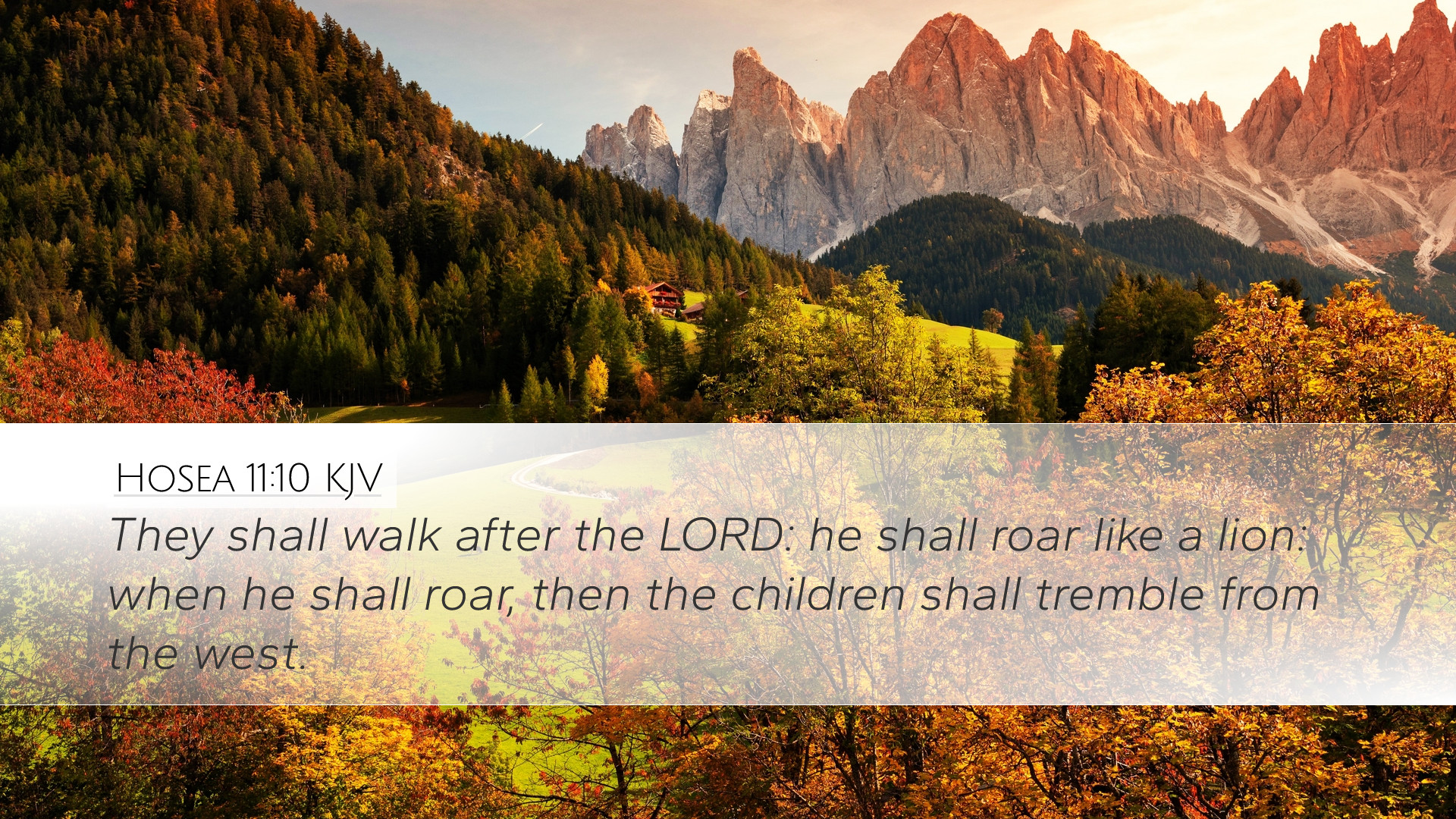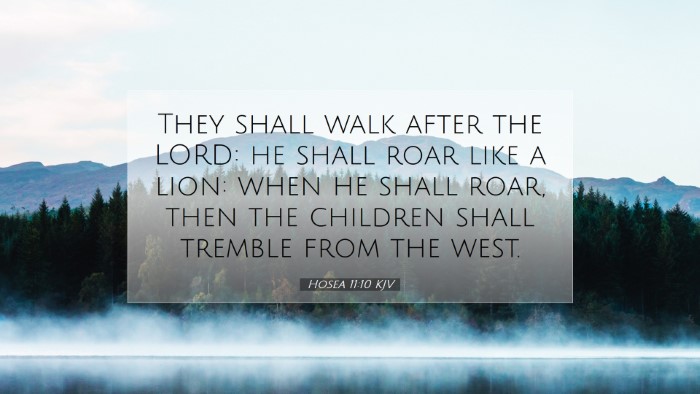Old Testament
Genesis Exodus Leviticus Numbers Deuteronomy Joshua Judges Ruth 1 Samuel 2 Samuel 1 Kings 2 Kings 1 Chronicles 2 Chronicles Ezra Nehemiah Esther Job Psalms Proverbs Ecclesiastes Song of Solomon Isaiah Jeremiah Lamentations Ezekiel Daniel Hosea Joel Amos Obadiah Jonah Micah Nahum Habakkuk Zephaniah Haggai Zechariah MalachiHosea 11:10
Hosea 11:10 KJV
They shall walk after the LORD: he shall roar like a lion: when he shall roar, then the children shall tremble from the west.
Hosea 11:10 Bible Commentary
Bible Commentary on Hosea 11:10
Verse Context: Hosea 11:10 states: "They shall go after the LORD: he shall roar like a lion: when he shall roar, then the children shall tremble from the west." This verse stands at the confluence of judgment, mercy, and restoration, encapsulating God's relationship with Israel in a profound way.
Introductory Insight
The verse encapsulates the dual nature of God's dealings with His people—both the call to repentance and the forewarning of His power. Hosea, as a prophet in the Northern Kingdom of Israel, speaks during a time of great disobedience and idolatry. This commentary draws from historic insights from public domain theologians to delve deeper into the theological implications of the text.
Commentary Insights
1. The Call to Return to the LORD
Matthew Henry emphasizes that the imagery of following the LORD signifies a collective return to faithfulness. The prophetic call indicates that achieving restoration requires recognition of past failures and a collective movement back to God. The word "that" implies not just an intention but a decisive action, indicative of repentance and surrender to the divine will.
2. The Powerful Voice of the LORD
Albert Barnes elaborates on the phrase "he shall roar like a lion." This metaphor expresses the majesty and authority of God. Just as a lion’s roar commands attention and instills fear, so does God's call. His authority is not to be taken lightly; it compels both respect and awe, driving the children of Israel to tremble from the west, which may signify a geographical or spiritual distance from Him.
3. The Trembling of the Children
Adam Clarke adds depth by interpreting the trembling of the children as a response to divine wrath and holiness. The trembling can also point to a reverent fear that leads to an understanding of their own frailty and need for divine mercy. This trembling is not merely fear but signifies a profound realization of the power of God, which brings with it an opportunity for restoration.
4. The Theological Implications
This verse underscores the idea of divine sovereignty, addressing the dynamic between God's holiness and human sinfulness. The language signifies a critical moment—where judgment is inevitable yet intertwined with the promise of restoration. The roar of the lion symbolizes God's calling, which, while fearful, is also an invitation to return and align with His purpose.
5. Historical Context and Application
Hosea operates against the backdrop of Israel’s cyclical infidelity, with God portrayed as a loving yet frustrated father (see Hosea 11:1-4). The call in verse 10 can be applied to contemporary believers confronting their estrangement from God through sin. It serves as a reminder that while God may chastise, His ultimate desire is reconciliation. The roaring lion can symbolize both judgment for impenitence and a loving father calling His children home.
6. The Nature of Repentance
True repentance involves a movement towards God that is marked by humility and a recognition of His power. As noted by Matthew Henry, they "shall go after the LORD" suggests a deliberate pursuit rooted in genuine contrition. This is foundational not only for individual faith journeys but also for communal restoration, which is critical for the church in contemporary society.
7. Reflections for Modern Believers
The contemporary church is called to heed the roar of God's authority. It prompts believers to reflect on their standing before God and inspires action towards holiness. Albert Barnes wisely remarks that recognizing God's voice is essential—"when he shall roar" signals a decisive moment of revelation that believers should actively respond to. The trembling serves as a spiritual awakening, beckoning believers to rekindle their relationship with God.
Conclusion: The Call to Action
Hosea 11:10 embodies the essence of God's relentless pursuit of His people. It invites each listener—pastors, students, theologians, and scholars—to contemplate their individual and collective roles in pursuing God. The metaphors of roar and trembling encapsulate the profound experience of encountering the Divine. May this passage stir our hearts to follow with fervor and live in reverence to the One who calls us back to Himself.


